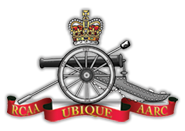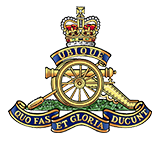The Inter-War Period
The First World War demonstrated that modern warfare placed very definite limitations on the role of horse artillery and horses in general. At its conclusion, the Canadian Government would reverse the decision in favour of two different types of artillery. The returning Canadian Contingent would not bring back its 13 Pdrs. The Defence Department made the 18 Pdr the uniform post-war gun for both horse and field artillery in Canada.
The “war to end all wars” philosophy which pervaded public thinking after the war resulted in political indifference for matters military, creating a climate in which there was little support for defence spending. It was decided to maintain a nucleus of young officers, Non-Commissioned Officers (NCOs) and specialists around which expansion could be quickly completed in the event of an emergency. Thus, between the two World Wars, the Permanent Force artillery was small and consisted of the RCHA Brigade, a medium battery, coast batteries and two Schools of Artillery. The RCHA Brigade with A and B Batteries was located at Kingston together with the 3rd Medium Battery. C Battery, RCHA Brigade was located at Winnipeg.
During the 1920’s the Non-Permanent Active Militia artillery batteries trained at local headquarters every winter and spent a week at practice camp in the summer. Units were small but keen, judging by the enthusiasm shown by most at the annual competitions fostered by the Royal Canadian Artillery Association (RCAA). Camps were conducted by the RCHA and the Schools of Artillery, and were held at Petawawa, Ontario; Shilo, Manitoba and Sarcee, Alberta. All of the wartime units and batteries soon began to hold annual reunions, where it became a tradition to sing “Auld Lang Syne” at the end of the formal dinner in honour of their fallen Gunner comrades.
In 1924 the Royal Canadian Garrison Artillery (RCGA) dropped the word “Garrison” from its name. At the same time, RCGA companies were renamed batteries. Various Militia units underwent nomenclature changes, and the terms CFA and CGA disappeared from Militia lists. All artillery units, aside from the RCHA Brigade, were designated RCA on 3 June 1935.
In 1929, the inevitable but sad day arrived, when The Regiment was informed that it was to become mechanized. Everyone had become deeply attached to their horses. Each horse was assigned a number and a name, the name starting with the battery letter in the RCHA. There are few military spectacles more stirring or picturesque than that of horse-drawn artillery, and crowds always turned out when the batteries appeared on the streets or highways. It is even recorded that when B Battery was proceeding to Camp Petawawa in the summer of 1909, the inhabitants of Smiths Falls, hearing that a stop-over was intended on the outskirts of their town, bought and laid 300 feet of piping for watering the horses.
The first unit to become mechanized was the 3rd Medium Battery, RCA. It was issued four 6-wheeled Leyland tractors in 1929 to tow its 60 Pdrs. A and B Batteries were mechanized in 1930, but it wasn’t until 1937 that C Battery parted with its horses. In 1931, seven militia field artillery brigades, one medium brigade and one medium battery were placed on the mechanized establishment. No mechanized transport was issued to these units for some years, however.
Between 1922 and the early thirties, when horses were replaced, all three batteries of the RCHA performed the Musical Drive at numerous events for the public. The popular mounted displays were based on the famous drive performed annually by the RHA. The Musical Drives had three main objects. As exhibitions of considerable colour, dash and skilful precision, they were designed to stimulate and maintain public interest in the Canadian Army, and the artillery in particular. They served to encourage recruiting among young men, for whom the varied skills in the artillery held a special appeal. Above all, for the Gunners themselves, the drives developed excellence in the technique of driving six-horse gun teams, they raised to a very high standard the care of horses and the maintenance of equipment, and they furnished soldiers with a special interest outside the day-to-day routine of service in peacetime. Wherever the Musical Drives were performed, spectators in their thousands, filling every seat, thrilled to the sight of four six-horse teams swinging their heavy guns and carriages at full gallop around the arena. The last drive was performed in Winnipeg in 1933, when Captain “Ham” Roberts (who 9 years later, as Major-General J.H. Roberts, would command the forces taking part in the Dieppe Raid) staged C Battery’s final display.
In keeping with advancements made in air warfare, the first Permanent Force anti-aircraft component of The RCA was raised in 1937 at Kingston. Designated the 4th Anti-Aircraft Battery, it was equipped with four 3-inch 20-cwt. guns and first conducted firing practice at Point Petre on Lake Ontario in the fall of 1938. In the following year it proceeded overseas as part of the 2nd Light Anti-Aircraft (LAA) Regiment.
The lack of defence spending during the inter-war years had taken its toll on the Canadian military. Despite the build-up of international tension from 1932 onward, the Defence Department went into World War Two ill-equipped to fight. A report by the Defence Minister in 1935 revealed a dismal shortage of modern equipment in all three services. The Minister described the situation with respect to the artillery as follows:
“…there was not a single modern anti-aircraft gun in Canada. The stock of field gun ammunition on hand represented a total of ninety minutes firing at normal rates for the field guns inherited from the Great War… and there were no reserves. Existing field artillery was unsuitable for mechanical traction and outranged by modern guns to the extent of 3,000 to 6,000 yards. Coast defence armaments were obsolescent and in many cases defective. Firing practice had been restricted in order to prolong life of the guns. Beyond a few tractors for guns of the Permanent Force batteries, no provision had been made for mechanical transport for defence purposes. Canada possessed no tanks or service armoured cars and no tractors for heavy and field artillery equipment…”
It would take three more years before plans were set in place to re-arm. Unfortunately, by that time the rising crisis in Europe caused the delay or cancellation of armament orders from overseas. With no defence industry of her own, Canada would have to wait her turn for up-to-date equipment to be made available.


